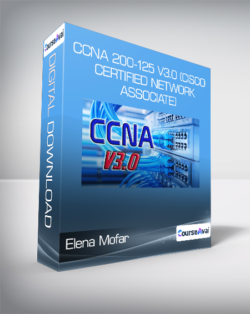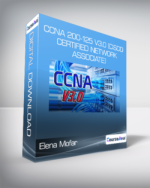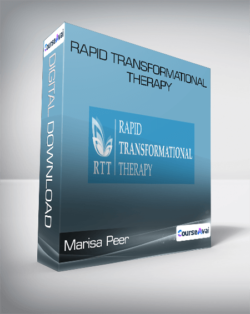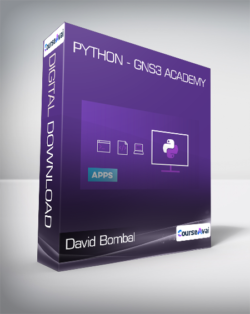The most in-depth CCNA Training you’ll ever find! Pass your CCNA Exam with confidence with this course!This course is created with only one goal in mind: “TO BE THE ONLY TRAINING RESOURCE YOU’LL EVER NEED TO PASS YOUR CCNA EXAM”Purchase Elena Mofar – CCNA 200-125 v3.0 (Cisco Certified Network Associate) courses at here with PRICE $7000 $947Elena Mofar – CCNA 200-125 v3.0 (Cisco Certified Network Associate)The most in-depth CCNA Training you’ll ever find! Pass your CCNA Exam with confidence with this course!This course is created with only one goal in mind: “TO BE THE ONLY TRAINING RESOURCE YOU’LL EVER NEED TO PASS YOUR CCNA EXAM”This course is self-paced, and can be accessed anytime, anywhere on any device!All Hands-on Exercises Would use Packet Tracer and GNS3.100++ Hours of TrainingLanguage of Delivery: Filipino – EnglishWhat is covered:This course covers everything in the CCNA curriculum. It fully covers CCNA Modules 1 – 4.Who should enroll:This course is designed for students with zero knowledge/no network background.How about hands-on activities?All hands-on exercises would use GNS3 and Packet Tracer.These are network simulators that would be installed in your computer for you to be able to configure Cisco routers and Switches at home. It will also enable you to virtualize different network scenarios, and topology that would surely enhance your skills in configuring Cisco devices.System Requirements for GNS3 and Packet Tracer activities:1. At least 2Ghz CPU Dual-core2. At least 2GB RAM3. Operating System:> Windows> Mac OS – You need to have VMWare fusion installed to run Packet Tracer in MacPrerequisites:No prerequisitesCourse Inclusions:1. Certficate of Completion2. All software and installers are provided inside the course3. Configuration and Lecture Notes.4. Lifetime Access—-Your InstructorElena MofarElena MofarHi, I’m your instructor for this course. I’ve been teaching Cisco and Linux courses for the past 10 years. I am a licensed ECE (Electronics and Communictions Engineer), RHCE (Red Hat Certified Engineer), CCNP and CCNA. And my primary goal in creating courses is for my students to not just learn but to understand how the network works, and to apply them in their jobs. I hope that you’ll find all my courses enlightening as I’ve made all my efforts in them to be so!Course CurriculumCourse IntroductionCisco Certification Path (46:39)How to use this course (4:05)CCNA 200-125 FILESPassword for ReviewerIntroduction to NetworkingElements of Good Network Design: Cost and LAN Speeds (73:33)Elements of Good Network Design: WAN Speeds (59:24)Elements of Good Network Design: Availability (20:33)Elements of Good Network Design: Reliability scalability security topology (22:25)Network Topology ( **NEW TOPIC**) (39:56)Lecture Slides [TO DOWNLOAD]OSI LayersOSI Layers Part 1 (12:27)OSI Layers part 2 (26:51)OSI LAYERS PART 3 (7:38)OSI Layers Part 4 (21:43)Encapsulation and deEncapsulation (27:07)Lecture Slides [TO DOWNLOAD]Transport LayerFeatures (20:28)Session Multiplexing (14:33)Three Way Handshake (27:15)Segmentation and Sequencing (19:16)Windowing and Sliding Windows Part 1 (23:43)Windowing and Sliding Windows Part 2 (17:12)Encapsulation Roundup (16:17)Lecture Slides [TO DOWNLOAD]Physical LayerEIA/TIA Standards (30:36)UTP Implementation (16:01)Ethernet Standards (23:56)Collision and Broadcast Domains Part 1 (20:15)Collision and Broadcast Domains Part 2 (19:16)Collision and Broadcast Domains Part 3 (15:25)Count how many Collision and Broadcast Domains (19:38)Lecture Slides (To Download)L2 and L3 EncapsulationsMAC Address Structure (9:25)DHCP Encapsulation & Process Part 1 (18:01)DHCP Encapsulation & Process Part 2 (15:14)IP Address, Network Address, Broadcast Address (14:27)ARP Encapsulation & Process (17:22)The Default Gateway Part 1 (16:34)The Default Gateway Part 2 (11:54)How a Router Routes Packets Thru the Internet (21:20)Lecture Slides (To Download)Subnetting: ConversionsBinary Introduction (13:45)Decimal to Binary Conversion (17:37)Binary to Decimal Conversion (12:43)Binary to Hexadecimal Conversion (11:31)Hexadecimal to Decimal Conversion (15:41)Decimal to Hexadecimal Conversion (18:34)Conversion ExercisesIPV4 Address StructureIP Address Classes – Network and Broadcast Address (19:46)IP Address Classes – Subnet Masks (12:19)Classes of IP Addresses (19:50)IPV4 Address Structure ExercisesSubnetting by Network RequirementSubnetting Requirements (12:47)Steps 1 and 2 : Getting Network and Number of Bits (11:51)Step 3 : Get New Subnet Mask (28:17)Step 4 : Getting Increment (9:27)Step 5 Part 1 : Getting the New Network Range (8:14)Step 5 Part 2 : Completing the Range (15:59)Step 5 Part 3 – When to stop adding increments (16:02)Getting Actual Networks and Usable Hosts (11:41)Subnetting b Network Requirement Class B Sample (24:48)Subnetting by Network Requirement Class A Sample (16:21)Subnetting by Network Reqt Exercises part 1 (27:09)Subnetting by Net Reqt Exercises Part 2 (12:30)Subnetting by Host RequirementClass C Sample (17:57)Class B Sample (8:22)Class A Sample (7:40)IP Subnet Zero (8:34)Reserved and Can’t be Assigned Addresses (12:38)Subnetting by Host Requirement Exercises Part 1 (22:49)Subnetting by Host Requirement Exerise Part 2 (18:20)VLSM (Variable Length Subnet Mask)VLSM Introduction (15:53)VLSM Sample Part 1 (20:42)VLSM Sample Part 2 (6:43)VLSM Exercise (19:30)VLSM Exercise PDFsReverse SubnettingReverse Subnetting Scenario 1 (35:39)Reverse Subnetting Scenario 2 Lecture (24:13)Reverse Subnetting Scenario 2 Exercises (24:38)Reverse Subnetting Scenario 3 Lecture (12:26)Reverse Subnetting Scenario 3 Exercises (7:15)Reverse Subnetting Scenario 4 Lecture (14:24)Reverse Subnetting Scenario 4 Exercises (16:44)Reverse Subnetting – Exception to Subnetting (16:35)SupernettingSupernetting Lecture Part 1 (20:03)Supernetting Lecture Part 2 (22:41)Supenetting Unequal networks part 1 (22:39)Supernetting Unequal Networks Part 2 – using shortcut method (17:36)Supernetting Exercises (16:28)Supernetting Exercise PDFsWildcard MasksWildcard Masks Lecture (20:01)Reverse supernetting with wildcard masks lecture (19:21)Reverse Subnetting with wildcard masks exercises (19:29)Wildcard Mask TableIntroduction to RoutersUnderstanding Router Specifications (40:09)Router Interfaces and Naming Conventions (41:34)Connecting Routers to WAN (12:19)Lecture Slides (To Download)Lab Simulation ToolsInstalling and Using Cisco Packet Tracer (20:29)How to Install and Use GNS3 (34:28)General Router ConfigurationsChecking router connection via CLI (22:28)Viewing router specifications using CLI (16:20)Cisco IOS Configuration Modes (13:48)Configuring Hostname and Enable Password (10:00)Configuring Line console and Line VTY (24:32)Encrypting passwords (17:01)Configuring Banners (9:21)General Router Configurations Lab ExerciseConfiguring Router Interface IP AddressesConfiguring Interface IP Addresses Part 1 (30:24)Configuring Interface IP Addresses Part 2 (24:04)How to Telnet and Suspend Telnet Sessions (30:15)Configuring Loopback IP Addresses (35:34)Configuring Interface IP Addresses Lab ExerciseConfiguration Notes [TO DOWNLOAD]Introduction to RoutingIntroduction to Routing – Lecture (23:53)Static RoutingStatic routing lecture part 1 (22:45)Static routing lecture part 2 (22:38)static routing lecture part 3 (25:03)static routing lecture part 4 (20:16)static routing lecture part 5 (16:20)configuring static default routes part 1 (23:09)configuring static default routes part 2 (20:55)Static and Default Routing Lab ExerciseConfiguration Notes [TO DOWNLOAD]Routing ProtocolsIGP vs EGP (16:24)Types of routing protocol according to algorithm (34:43)Lecture Slides (To Download)RIP (**NEW SECTION**)RIP Lab Files (PLEASE DOWNLOAD FIRST)RIP Initial Lab Setup (15:06)Configuring RIP Part 1 (25:14)Configuring RIP Part 2 (24:32)How RIP Works Part 1 (45:08)How RIP Works Part 2 (39:34)How RIP Works Part 3 (17:04)How RIP Works Part 4 (37:57)How RIP Works Part 5 (20:41)Configuring RIP Passive Interfaces (33:19)Troubleshooting RIP (14:37)EIGRPEIGRP Initial Lab Setup (20:22)Configuring EIGRP Part 1 (22:43)Configuring EIGRP Part 2 (23:21)Configuring EIGRP Part 3 (13:18)How EIGRP Works Part 1 (19:03)How EIGRP Works Part 2 (15:07)How EIGRP Works Part 3 (12:27)How EIGRP Works Part 4 (13:19)How EIGRP Works Part 5 (6:19)EIGRP Terminologies (24:52)Viewing the EIGRP Tables (22:56)Configuring Interface Bandwidths Part 1 (25:46)Configuring Interface Bandwidths Part 2 (17:38)EIGRP Unequal-Cost Load Balancing Lecture (28:10)Configuring Unequal-Cost Load Balancing (10:09)The No Auto-Summary Effect (26:42)Configuring EIGRP Passive Interfaces Part 1 (17:50)Configuring EIGRP Passive Interfaces Part 2 (9:00)Configuring EIGRP Authentication Part 1 (21:17)Configuring EIGRP Authentication Part 2 (14:09)EIGRP Troubleshooting Exercises (12:39)Troubleshooting EIGRP (22:20)EIGRP Lab ExerciseTSHOOT LABSConfiguration Notes [TO DOWNLOAD]OSPFConfiguring Single Area OSPF (28:12)OSPF Router-ID Lecture (27:59)Configuring OSPF Router-ID (12:27)Configuring OSPF Passive Interfaces (18:55)Configuring OSPF Authentication (27:06)Establishing OSPF Neighbor Adjacency Part 1 (40:41)Establishing OSPF Neighbor Adjacency Part 2 (33:14)Establishing OSPF Neighbor Adjacency Part 3 (18:28)Establishing OSPF Neighbor Adjacency Part 4 (45:50)OSPF Areas (54:54)Multi-Access OSPF (21:18)Configuring Multi-Area OSPF Lab Setup (7:11)Configuirng Multi-Area OSPF Part 1 (23:45)Configuring Multi-Area OSPF Part 2 (22:49)Configuring Multi-Area OSPF Part 3 (9:45)Configuring Multi-Area OSPF Lab Part 4 – Default Information Originate (16:08)OSPF Lab ExerciseConfiguration Notes [TO DOWNLOAD]IPV6The Need for IPV6 (17:18)IPV6 Address Structure (6:48)Abbreviating IPV6 Addresses (16:57)Determining IPV6 Address Prefix (22:03)Determining IPV6 Prefix Exercises (11:05)Types of IPV6 Addresses (8:39)Link Local IPV6 Address – Getting the EUI-64 Address (12:25)2 Ways to Configure IPV6 Addresses (23:24)Configuring Interface IPV6 Addresses Part 1 (21:45)Configuring Interface IPV6 Addresses Part 2 (8:32)Configuring IPV6 Loopback Interfaces (14:58)Configuring OSPFv3 Part 1 (25:44)Configuring OSPFv3 Part 2 (15:18)Configuring EIGRP for IPV6 (30:17)Configuring Static Routing for IPV6 (21:50)Configuring Static Default Routes in IPV6 (16:10)IPV6 LAB ExerciseConfiguration Notes ( To download )Access Control Lists (ACL)ACL Introduction (17:33)Configuring Standard ACL Part 1 (31:37)Configuring Standard ACL Part 2 (22:47)Configuring Standard ACL part 3 (46:41)Configuring Standard ACL Restricting Telnet Access Part 1 (31:39)Configuring Standard ACL Restricting Telnet Access Part 2 (13:10)Configuring Extended ACL part 1 (25:18)Configuring Extended ACL part 2 (37:37)Configuring Named Standard ACL (18:32)Configuring Named Extended ACL (14:08)Configuration Notes (To download)Alternate Download Link for all lecturesNAT ( Network Address Translation )Lecture (27:39)Configuring Dynamic NAT Part 1 (39:20)Configuring Dynamic NAT Part 2 (14:26)NAT Terminologies (7:21)Configuring Static NAT (15:11)Configuration Notes ( To Download )BGP Lecture Series ***NEW SECTION***BGP Lecture Part 1 (35:40)BGP Lecture Part 2 (15:16)BGP Lecture Part 3 (8:13)BGP Neighbor States (44:17)Get Elena Mofar – CCNA 200-125 v3.0 (Cisco Certified Network Associate) downloadBGP Configuration Series **New Section**BGP GNS3 Lab Topologies (PLEASE DOWNLOAD!!)BGP Singlehomed Lab Setup (15:51)BGP Singlehomed Lab Configuration Part 1 (25:16)BGP Singlehomed Lab Configuration Part 2 (47:23)BGP Singlehomed Lab Configuration Part 3 (30:47)BGP Multihomed Lab Setup (20:37)BGP Multihomed Configuration Part 1 (20:45)BGP Multihomed Configuration Part 2 (28:36)BGP Multihomed Configuration Part 3 (37:18)BGP Exercise LabBGP Configuration Notes (To Download)RedundanciesConfiguring Floating Static Routes (26:08)FHRP Lecture (33:39)Configuring HSRP Lab Setup (16:35)Configuring HSRP Part 1 (26:15)Configuring HSRP Part 2 (7:49)Configuring HSRP Verification and Testing (17:56)Configuring VRRP (16:36)Configuring VRRP Verification and Testing (9:43)Configuration Notes (To download)VPN (Virtual Private Network)VPN Lecture (35:18)Configuring GRE Tunnel Part 1 (20:04)Configuring GRE Tunnel Part 2 (24:41)Configuring GRE Tunnel Part 3 (12:24)Configuration Notes (To Download)DHCPConfiguring DHCP on Cisco Routers (24:51)Configuration Notes (To Download)SSHConfiguring SSH Lab Setup (1:27)Configuring SSH (49:08)Configuration Notes (To download)CDP ( Cisco Discovery Protocol )CDP Lecture (16:23)WAN EncapsulationsWAN Encapsulations Lecture (20:13)Configuring PPP Authentication Part 1 (25:21)Configuring PPP Authentication Part 2 (13:48)Configuring Point-to-Point Frame-Relay Subinterfaces Part 1 (26:34)Configuring Point-to-Point Frame-Relay Subinterfaces Part 2 (25:35)Configuring Point-to-Point Frame-Relay Subinterfaces part 3 (11:23)Configuring Point to Multipoint Frame-Relay Part 1 (19:42)Configuring Point to Multipoint Frame-Relay Part 2 (24:30)Configuring Point to Multipoint Frame-Relay Part 3 (22:51)Configuring Point to Multipoint Frame-Relay Part 4 (27:39)Configuration Notes (To download)General Switch ConfigurationsGeneral Switch Configurations Part 1 (12:04)General Switch Configurations Part 2 (25:23)General Switch Configurations Part 3 (12:34)Switchport Modes DTP lecture (19:31)General Switch Configurations Part 4 Configuring switchport modes (23:46)General Switch Configurations Part 5 – Configuring Switchport Modes (32:23)Basic Switch Operations Part 1 (34:49)Basic Switch Operations Part 2 (24:45)Configuring Switchport Security Part 1 (23:11)Configuring Switchport Security Part 2 (21:37)Configuring Switchport Security Part 3 (21:33)Configuration Notes (To Download)VLANS (Virtual Lans)VLAN Lecture (22:30)Configuring VLANs (24:47)Configuration Notes (To download)VTP (Virtual Trunking Protocol)VTP Lecture (37:15)Configuring VTP (35:30)Configuration Notes (To download)Trunking EncapsulationTrunking Encapsulations Lecture (21:39)Configuring Trunking Encapsulations (25:51)Native VLAN Lecture (15:51)Configuring Native Vlans (21:56)Configuration Notes (To download)Intervlan Routing/Router-on-a-StickIntervlan Routing Lab Setup (22:51)Intervlan Routing Lecture Part 1 (32:21)Intervlan Routing Lecture Part 2 (13:44)Configuring Intervlan Routing Part 1 (29:42)Configuring Intervlan Routing Part 2 (27:46)Configuring Intervlan Routing Part 3 (28:04)Configuration Notes (To Download)Multilayer SwitchingThe Need for Multilayer Switching (17:25)Configuring Multilayer Switching Lab Setup (19:44)Configuring Multilayer Switching Part 1 (25:28)Configuring Multilayer Switching Part 2 (20:43)Configuring Multilayer Switching Part 3 (23:16)Configuring HSRP and VRRP on Multilayer Switches Lab Setup (17:33)Configuring HSRP on Multilayer Switches Part 1 (22:16)Configuring HSRP in Multilayer Switches Part 2 (22:17)Configuring HSRP in Multilayer Switches Part 3 (13:38)Configuring VRRP in Multilayer Switches Part 1 (20:57)Configuring VRRP on Multilayer Switches Part 2 (6:52)Configuring DHCP over Multiple VLANs Lab Setup (9:24)Configuring DHCP over Multiple Vlans Part 1 (19:39)Configuring DHCP over Multiple VLANs Part 2 (30:11)Configuration Notes (To Download)Spanning Tree ProtocolThe Need for STP (21:52)STP Process Part 1 (19:59)STP Process Part 2 (25:28)STP Process Part 3 (24:16)STP Process Part 4 (18:52)STP Process Part 5 (24:19)Configuring Spanning Tree Part 1 (20:41)Configuring Spanning Tree Part 2 (8:15)Configuring Spanning Tree Part 3 (15:52)STP Enhancements (15:18)Configuring Portfast and BPDU Guard (30:03)Etherchannel and Link AggregationEtherchannel Lecture (29:50)Configuring Etherchannels Part 1 (24:47)Configuring Etherchannels Part 2 (23:39)Configuring Etherchannel Part 3 (16:33)Configuring Etherchannels Part 4 (19:19)Configuring Etherchannels Part 5 (20:26)Configuration Notes (To Download)Certificate of CompletionSales PageArchive Page Purchase Elena Mofar – CCNA 200-125 v3.0 (Cisco Certified Network Associate) courses at here with PRICE $7000 $947
 Ray Reynolds – Business Credit Masters Founder Kit
₹31,374.00
Ray Reynolds – Business Credit Masters Founder Kit
₹31,374.00
 The Art of Charm – Social Capital Networking Intensive
₹19,754.00
The Art of Charm – Social Capital Networking Intensive
₹19,754.00
Elena Mofar – CCNA 200-125 v3.0 (Cisco Certified Network Associate)
₹157,202.00






